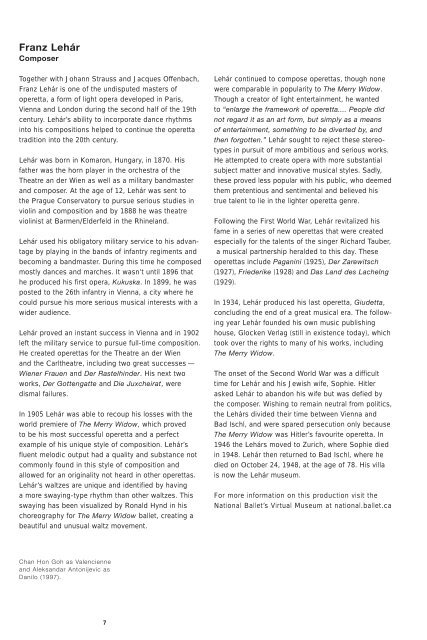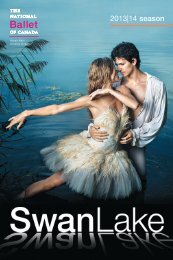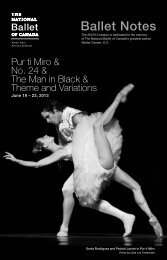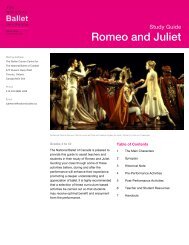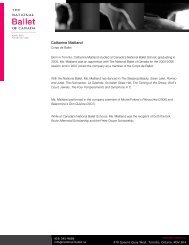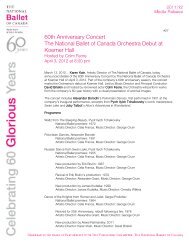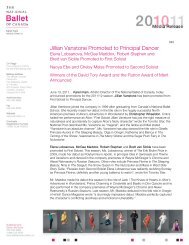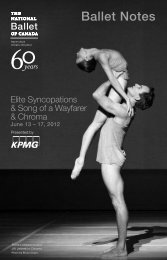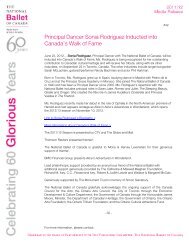The Merry Widow - The National Ballet of Canada
The Merry Widow - The National Ballet of Canada
The Merry Widow - The National Ballet of Canada
You also want an ePaper? Increase the reach of your titles
YUMPU automatically turns print PDFs into web optimized ePapers that Google loves.
Franz Lehár<br />
Composer<br />
Together with Johann Strauss and Jacques Offenbach,<br />
Franz Lehár is one <strong>of</strong> the undisputed masters <strong>of</strong><br />
operetta, a form <strong>of</strong> light opera developed in Paris,<br />
Vienna and London during the second half <strong>of</strong> the 19th<br />
century. Lehár’s ability to incorporate dance rhythms<br />
into his compositions helped to continue the operetta<br />
tradition into the 20th century.<br />
Lehár was born in Komaron, Hungary, in 1870. His<br />
father was the horn player in the orchestra <strong>of</strong> the<br />
<strong>The</strong>atre an der Wien as well as a military bandmaster<br />
and composer. At the age <strong>of</strong> 12, Lehár was sent to<br />
the Prague Conservatory to pursue serious studies in<br />
violin and composition and by 1888 he was theatre<br />
violinist at Barmen/Elderfeld in the Rhineland.<br />
Lehár used his obligatory military service to his advantage<br />
by playing in the bands <strong>of</strong> infantry regiments and<br />
becoming a bandmaster. During this time he composed<br />
mostly dances and marches. It wasn’t until 1896 that<br />
he produced his first opera, Kukuska. In 1899, he was<br />
posted to the 26th infantry in Vienna, a city where he<br />
could pursue his more serious musical interests with a<br />
wider audience.<br />
Lehár proved an instant success in Vienna and in 1902<br />
left the military service to pursue full-time composition.<br />
He created operettas for the <strong>The</strong>atre an der Wien<br />
and the Carltheatre, including two great successes —<br />
Wiener Frauen and Der Rastelhinder. His next two<br />
works, Der Gottengatte and Die Juxcheirat, were<br />
dismal failures.<br />
In 1905 Lehár was able to recoup his losses with the<br />
world premiere <strong>of</strong> <strong>The</strong> <strong>Merry</strong> <strong>Widow</strong>, which proved<br />
to be his most successful operetta and a perfect<br />
example <strong>of</strong> his unique style <strong>of</strong> composition. Lehár’s<br />
fluent melodic output had a quality and substance not<br />
commonly found in this style <strong>of</strong> composition and<br />
allowed for an originality not heard in other operettas.<br />
Lehár’s waltzes are unique and identified by having<br />
a more swaying-type rhythm than other waltzes. This<br />
swaying has been visualized by Ronald Hynd in his<br />
choreography for <strong>The</strong> <strong>Merry</strong> <strong>Widow</strong> ballet, creating a<br />
beautiful and unusual waltz movement.<br />
Chan Hon Goh as Valencienne<br />
and Aleksandar Antonijevic as<br />
Danilo (1997).<br />
7<br />
Lehár continued to compose operettas, though none<br />
were comparable in popularity to <strong>The</strong> <strong>Merry</strong> <strong>Widow</strong>.<br />
Though a creator <strong>of</strong> light entertainment, he wanted<br />
to “enlarge the framework <strong>of</strong> operetta.... People did<br />
not regard it as an art form, but simply as a means<br />
<strong>of</strong> entertainment, something to be diverted by, and<br />
then forgotten.” Lehár sought to reject these stereotypes<br />
in pursuit <strong>of</strong> more ambitious and serious works.<br />
He attempted to create opera with more substantial<br />
subject matter and innovative musical styles. Sadly,<br />
these proved less popular with his public, who deemed<br />
them pretentious and sentimental and believed his<br />
true talent to lie in the lighter operetta genre.<br />
Following the First World War, Lehár revitalized his<br />
fame in a series <strong>of</strong> new operettas that were created<br />
especially for the talents <strong>of</strong> the singer Richard Tauber,<br />
a musical partnership heralded to this day. <strong>The</strong>se<br />
operettas include Paganini (1925), Der Zarewitsch<br />
(1927), Friederike (1928) and Das Land des Lachelng<br />
(1929).<br />
In 1934, Lehár produced his last operetta, Giudetta,<br />
concluding the end <strong>of</strong> a great musical era. <strong>The</strong> following<br />
year Lehár founded his own music publishing<br />
house, Glocken Verlag (still in existence today), which<br />
took over the rights to many <strong>of</strong> his works, including<br />
<strong>The</strong> <strong>Merry</strong> <strong>Widow</strong>.<br />
<strong>The</strong> onset <strong>of</strong> the Second World War was a difficult<br />
time for Lehár and his Jewish wife, Sophie. Hitler<br />
asked Lehár to abandon his wife but was defied by<br />
the composer. Wishing to remain neutral from politics,<br />
the Lehárs divided their time between Vienna and<br />
Bad Ischl, and were spared persecution only because<br />
<strong>The</strong> <strong>Merry</strong> <strong>Widow</strong> was Hitler’s favourite operetta. In<br />
1946 the Lehárs moved to Zurich, where Sophie died<br />
in 1948. Lehár then returned to Bad Ischl, where he<br />
died on October 24, 1948, at the age <strong>of</strong> 78. His villa<br />
is now the Lehár museum.<br />
For more information on this production visit the<br />
<strong>National</strong> <strong>Ballet</strong>’s Virtual Museum at national.ballet.ca


